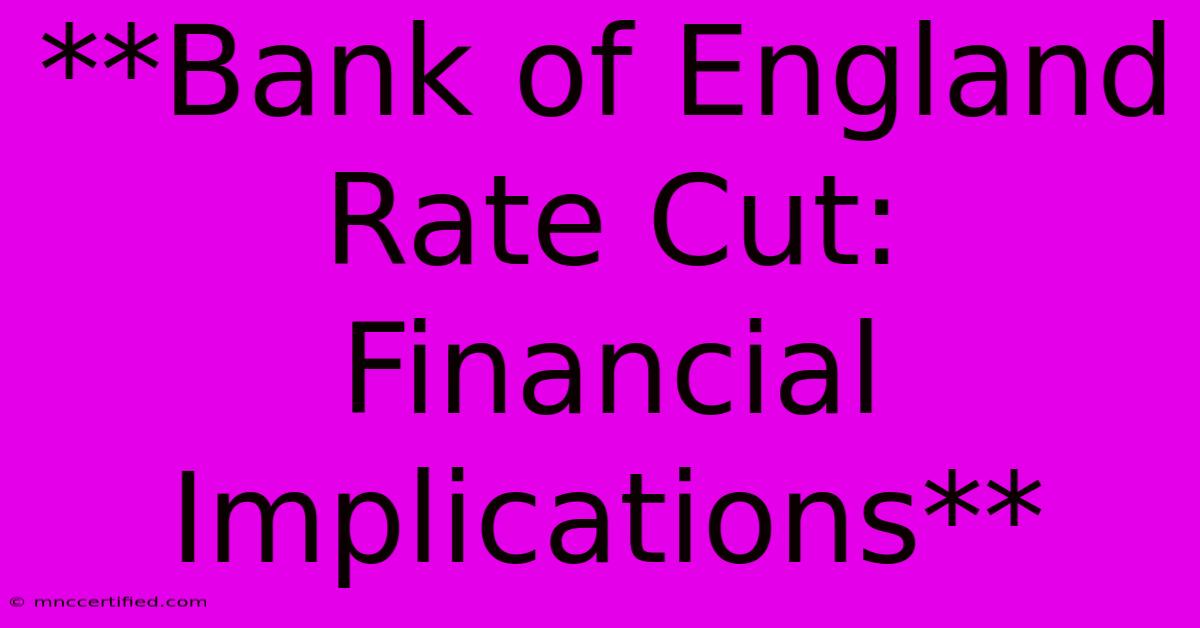**Bank Of England Rate Cut: Financial Implications**

Table of Contents
Bank of England Rate Cut: Financial Implications
The Bank of England (BoE) plays a crucial role in the UK economy by setting interest rates and managing the money supply. Recently, the BoE made a decision to cut interest rates, a move that has significant implications for individuals, businesses, and the overall financial landscape. This article delves into the potential consequences of this rate cut, exploring both the positive and negative aspects.
Understanding the Impact of Interest Rate Cuts
A rate cut refers to a decrease in the base rate, the benchmark interest rate at which banks lend money to each other. This decision has a ripple effect throughout the financial system:
-
Cheaper Borrowing Costs: Lower interest rates translate into cheaper borrowing costs for businesses and individuals. This can stimulate investment and consumer spending as mortgages, loans, and credit cards become more affordable.
-
Encourages Economic Growth: The hope behind rate cuts is to encourage economic activity. Reduced borrowing costs incentivize businesses to expand operations, hire more employees, and invest in projects. This, in turn, can boost economic growth.
-
Weakening Pound Sterling: A lower interest rate can make the pound sterling less attractive to foreign investors. This can lead to a weakening of the pound's exchange rate, potentially making imports more expensive and exports cheaper.
-
Inflationary Pressure: While rate cuts aim to stimulate the economy, they can also lead to inflationary pressure. Cheaper borrowing costs can encourage excessive spending and investment, potentially driving up demand and prices.
Potential Benefits of a BoE Rate Cut
-
Boost to Economic Growth: The primary goal of a rate cut is to stimulate economic growth. By making it cheaper for businesses and consumers to borrow money, the BoE hopes to encourage investment, spending, and job creation.
-
Relief for Borrowers: Individuals and businesses with existing loans can benefit from reduced interest payments, freeing up cash flow for other purposes. This could lead to increased spending and investment, further contributing to economic growth.
-
Support for struggling businesses: In times of economic uncertainty, a rate cut can provide a lifeline to struggling businesses by reducing their financing costs and easing pressure on cash flow.
Potential Risks of a BoE Rate Cut
-
Inflationary Pressure: A major concern is the potential for a rate cut to fuel inflation. Increased borrowing and spending could lead to higher demand for goods and services, putting upward pressure on prices.
-
Asset Bubble: A prolonged period of low interest rates can create an environment for asset bubbles, particularly in the housing market. This can create financial instability and potential risks of a future crash.
-
Weakening Pound Sterling: A lower interest rate can make the pound less attractive to foreign investors, potentially leading to a depreciation of the currency. This can make imports more expensive and exports cheaper, potentially impacting businesses and consumers.
Conclusion
The Bank of England's decision to cut interest rates is a complex issue with both potential benefits and risks. While it can stimulate economic growth and provide relief for borrowers, it can also lead to inflationary pressure, a weaker pound, and asset bubbles.
The ultimate impact of this decision will depend on a variety of factors, including the severity of the economic slowdown, the response of businesses and consumers, and the effectiveness of other policy measures. It is essential to monitor the situation closely and assess the long-term consequences of this rate cut on the UK economy.

Thank you for visiting our website wich cover about **Bank Of England Rate Cut: Financial Implications** . We hope the information provided has been useful to you. Feel free to contact us if you have any questions or need further assistance. See you next time and dont miss to bookmark.
Featured Posts
-
Directors And Officers Insurance For Hoa
Nov 08, 2024
-
Outer Banks Season 4 Recap Before Part 2
Nov 08, 2024
-
Bank Of England Cuts Rates To 4 75
Nov 08, 2024
-
Chelsea Starting Xi Noah Match
Nov 08, 2024
-
Customer Onboarding Process In Insurance
Nov 08, 2024